How Custom Wooden Keychains Are Made?
Custom keychains might be small, but they sure pack a punch. Aussie makers and gift-givers are all over them — a top pick when you want something personal, handcrafted, and a little bit special. From birthdays to branding kits, these wooden beauties are turning heads. For a broader overview on styles and ordering options, see How to Make Custom Keychains and Where to Get Custom Keychains Made.
There’s a certain magic in watching a plain slab of timber become a one-of-a-kind piece. It’s not just cutting and sanding — it’s about knowing your wood, using what you’ve got wisely, and adding that finishing touch that makes people go, “Wow.” If you’re comparing materials and finishes across different formats, AllGoodsHub’s primer on Types of Custom Keychains helps set expectations for results and durability.
“Allgoodshub’s lead designer, Matty Chen, says, ‘We don’t just make keychains — we build tiny stories in timber.’” Short, sharp, and straight from the shop floor. For real-world shopping or bulk enquiries in Australia, start here: custom keychains Australia.
If you’ve ever binned a miscut board or struggled with faded engraving, you're not alone. This guide’s for folks who want clean cuts, bold finishes, and no wasted time or materials. (If you’re exploring alternative materials like PVC or metal for mixed sets, check best custom keychains.)
We’ll walk through the process — start to finish — and share tips to make your custom keychain builds smoother, sharper, and more sellable. For readers weighing DIY vs. outsourcing, AllGoodsHub’s article on Where Can I Make Custom Keychains covers practical options for Australia-based orders.
Tired of wasted wood? Optimize cuts for custom keychains
Efficient Layouts for Round and Rectangle Keychains
Nailing the layout is where your material cost either spikes or saves big. Here's how smart makers do it:
Start by placing keychain blanks close together in your digital layout — use nesting software if you're going pro (see widely used tools like SVGnest – Free Nesting Software and Deepnest (open source)).
Always account for kerf width (that tiny amount your blade or laser eats up). It adds up fast — refresher here: What Is Cutting Kerf and Why It Matters.
Wood grain matters. Align your round or rectangle keychains with it to reduce cracks or edge chipping (see grain-direction cutting discussion in the LightBurn forum and a machining study on cutting forces vs. grain).
Want clean cuts every time? Use CNC routing or laser cutting to maximize material yield; layout guidance and warping considerations are covered in SendCutSend’s explainer on warping in laser-cut parts.
Pro tip: the more blanks you get per board, the less you waste — and the more you earn. To compare categories for your lineup, browse AllGoodsHub’s Keychain Types Explained.
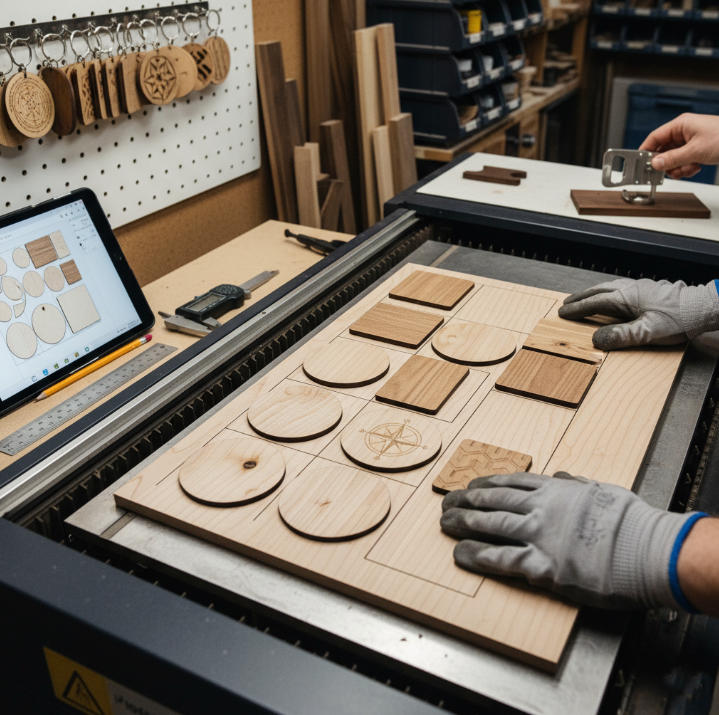
Minimizing Waste in Rustic Wood Engraving Projects
Rustic looks aren’t rough on purpose — they’re calculated. Minimizing waste while keeping that authentic vibe means working smart with flawed material.
Use reclaimed wood with character. Cracks, color variation, and knots? They're features, not flaws (see benefits of reclaimed stock in this 2025 guide: How Reclaimed Wood Helps the Earth).
Wood scraps from other jobs can become small batch or mini keychain designs (general reclaimed practices: Sustainable Woodworking With Reclaimed Wood).
Fill unwanted holes with wood filler or epoxy resin instead of tossing the whole piece (for resin inlays/fills, see: How to Apply Resin to Laser-Cut Projects).
A solid move: group multiple engraving patterns close together when working with oddly shaped planks. The trick is not to force perfection — lean into the rustic charm while still focusing on waste reduction and smart material sourcing.
Choosing the Right Wood Thickness for Bottle Opener Designs
Durability meets design when you build bottle openers into your custom keychains. But thickness isn’t just about aesthetics — it’s a deal-breaker for strength.
Step 1: Know your opener hardware
Match the hardware size and placement to your design. If it’s too thick, it won't mount right. Too thin? You’ll snap it before the first cap. (Hardware/handle workflow example: Rockler’s guide to Making Hardwood Bottle Opener Handles). If you prefer ready-made options, explore AllGoodsHub’s Custom Branded Zinc Alloy Bottle Opener Keychains for hybrid wood–metal gift sets.
Step 2: Balance strength and bulk
Hardwoods like maple or walnut resist wood bending, giving better leverage without feeling bulky in the pocket (hardwood durability for engraving noted here: Best Wood for Laser Engraving).
Step 3: Watch your tolerances
Aim for a thickness tolerance of around 8–10mm. Anything under that and you risk compromising the durability of your product. (When in doubt, prototype with your specific hardware kit — e.g., common bottle opener hardware kits).
Step 4: Match the species to the job
Light wood species like pine? Skip them. For opener builds, go with something denser (species selection considerations: How to Choose the Best Wood for Laser Engraving).
Step 5: Test before you batch
Run a test fit of your hardware before producing in volume. Adjust as needed — your woodworker reputation depends on it. If you decide to offer a mix of functional designs, AllGoodsHub’s Custom Printed Tin Bottle Opener Keychains are a popular upsell in corporate kits.
5 Steps to Craft a Custom Wooden Keychain
A no-fluff guide to crafting wooden keychains that look pro-level without the hassle.
Step 1: Selecting Between Oak and Teak Wood Bases
Oak has a tighter grain and takes detail like a champ — great for artistic engravings.
Teak is naturally oily and weather-resistant, perfect for rugged or outdoor keychains (overview: Teak vs Oak – Pros & Cons and Teak vs Oak for Outdoor Use).
Wood selection isn’t just about looks. Teak's darker tones match rustic vibes; oak gives off a cleaner, modern feel.
Keep in mind: the grain direction affects cutting smoothness and finish quality (see reading grain & avoiding tear-out).
Choose your base material based on where it’s going and who it’s for. For project-by-project help, see AllGoodsHub’s Top Materials for Bulk Custom Keychains.
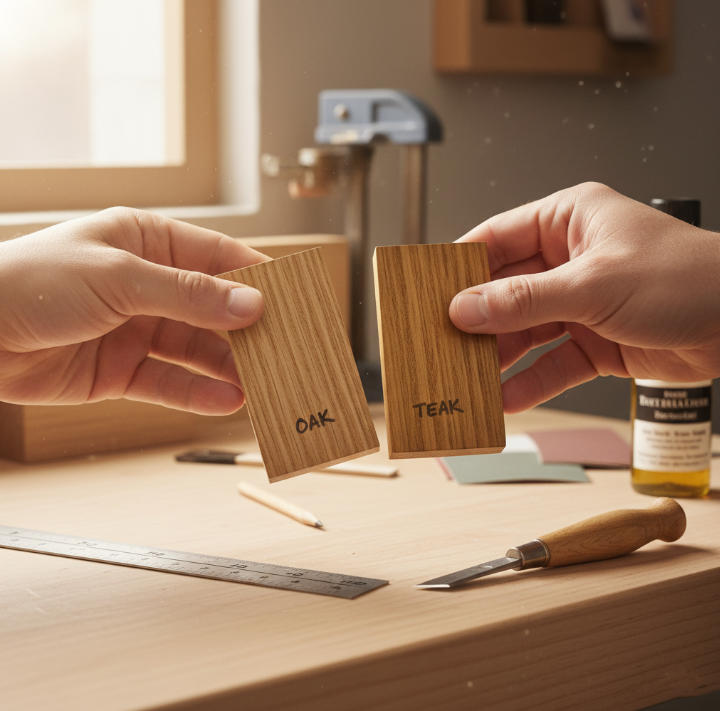
Step 2: Cutting Square, Oval, and Heart Shapes Precisely
Getting those cute Heart, Oval, or clean Square keychains just right? It’s all about tool handling and layout planning.
Mark your shape using templates or stencils — way faster than freehand.
Use a scroll saw or laser cutter for cleaner edges and fewer do-overs (see practical walkthroughs like Laser Engraved Keychain and general layout tips in 10 Tips & Tricks for Laser Engraving/Cutting).
Secure the wood base — wobbly materials = jagged shapes.
For shapes like hearts, go slow on the curves to avoid split-outs.
After cutting, always check for symmetric balance, especially for display pieces.
Cutting isn’t just slicing wood — it’s how your keychain first introduces itself to the world.
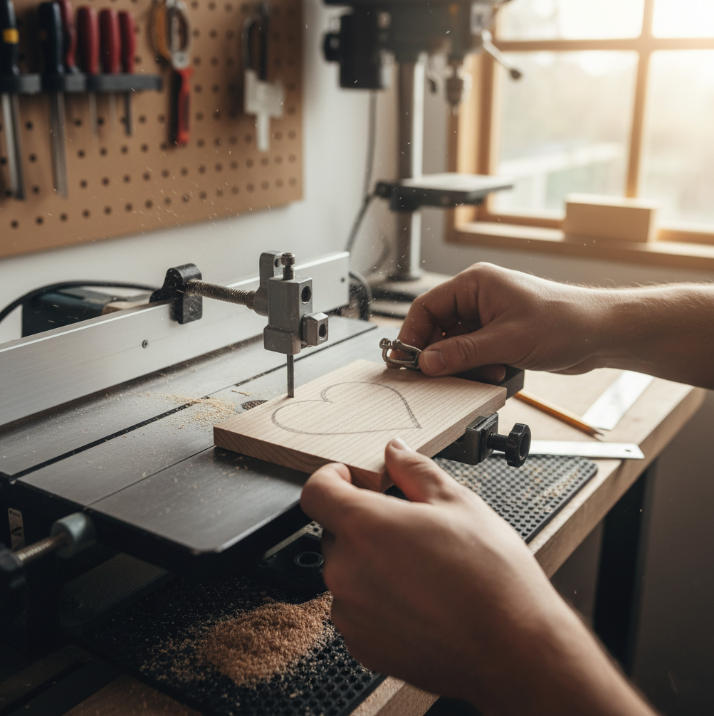
Step 3: Sanding Techniques for a Smooth Minimalist Finish
Start with coarse grit (80–100) to level imperfections.
Move to finer grits (150–220) for soft, skin-friendly edges (grit progression explained here: Sanding Wood — What Grits to Use).
Use beveled sanding blocks for corners and shape curves.
Sand with the grain — don’t fight it.
Avoid over-sanding thin parts (hello, breakage!).
Keep it simple. A clean, minimalist finish always wins.
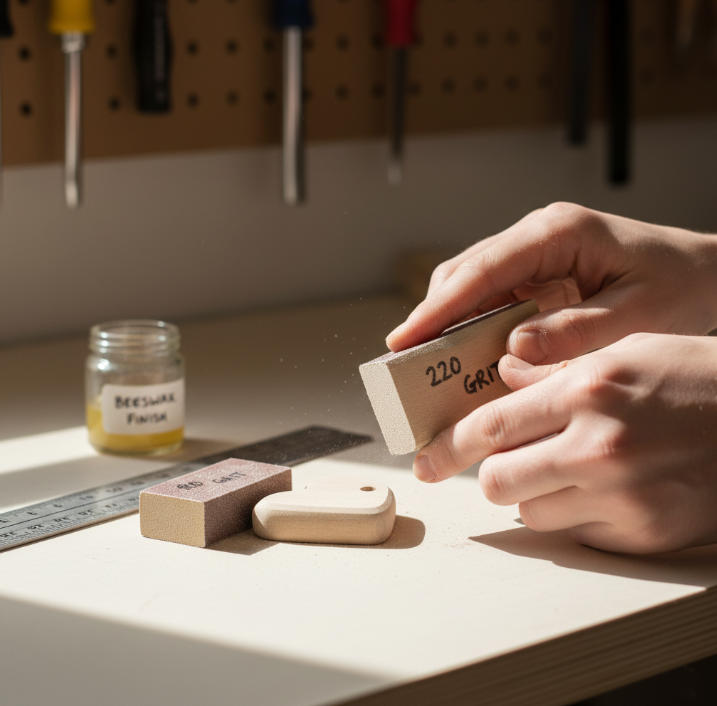
Step 4: Engraving Personalized Messages with Laser or Manual Tools
Engraving adds soul — the part that makes a custom keychain theirs.
Manual tools (like chisels or electric engravers) give off that hand-touched feel. Ideal for rustic or one-off designs.
Laser engraving is perfect for high-volume or precise work — logos, names, even quotes (wood-density/engraving pointers: Best Wood for Laser Engraving — xTool).
Go with simple fonts on smaller pieces to keep readability.
Align text with the shape — curved message on a heart? Cute and smart.
Use masking tape over the wood for cleaner laser lines and less burn (see masking technique: Prevent Burn Marks When Engraving Wood).
It’s not just design. It’s personalization, and that’s what sells. If you’re considering professionally made alternatives, compare AllGoodsHub’s Custom Double-Sided Domed Keyring for photo/logo applications.
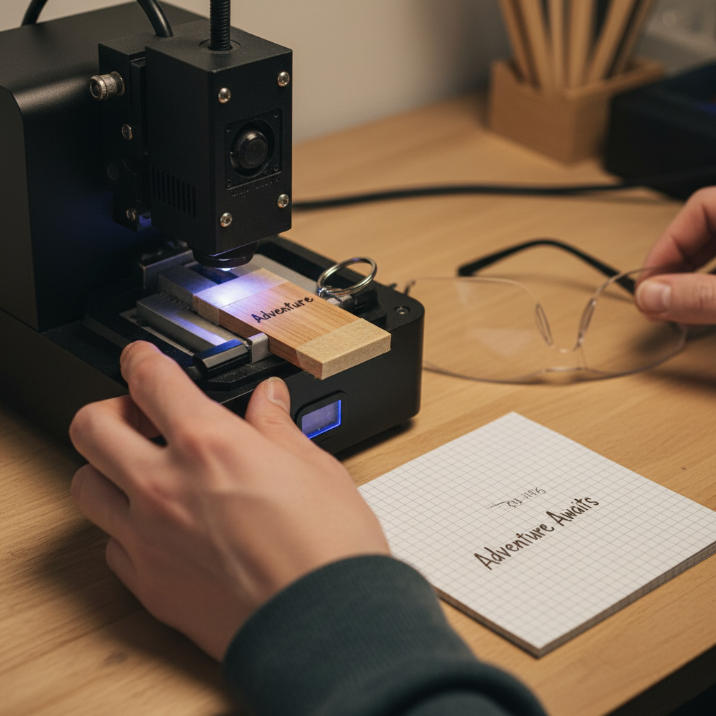
Step 5: Finishing Touches with Gold, Teal, or Bronze Accents
This is the flair phase — when your wooden keychain gets its wow factor.
Add Gold or Bronze hooks or hardware to give a polished look (polished metal options: Promotional Metal Gifts Australia).
Use Teal paint or resin fills in engraved areas to make designs pop; for technique, see resin inlay demos like How to Apply Resin to Laser-Cut Projects.
Want to boost elegance? Pair a Gold keyring with an Oak body. Instant class.
For something more playful, mix Bright Teal finishes with Heart or Star shapes.
Apply a clear coat to seal the color and protect the wood.
Color accents are tiny, but they take your design from DIY to Etsy-star level. For complementary non-wood add-ons in mixed gift packs, see AllGoodsHub’s Custom Carabiner Keychains in 13 Colours.
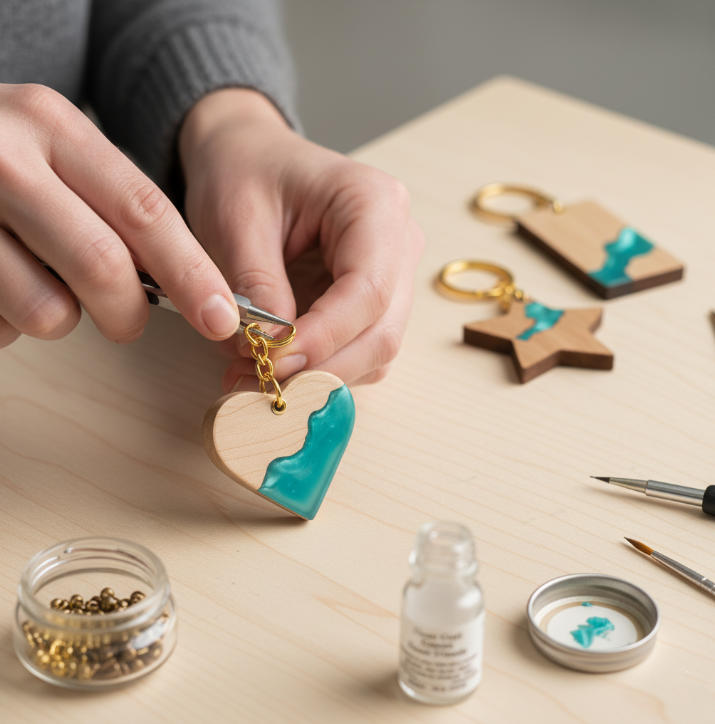
How do artisans choose the best wood for engraving?
Soft vs. Hard Wood for Detailed Artistic Themes
Softwood like basswood is friendly for beginners, giving a smooth surface for broad artistic themes. Hardwood, such as cherry, holds fine engraving detail but pushes tools harder. Many artisans blend both worlds: softwood for casual, expressive designs and hardwood when precision really matters. The choice sets the tone, balancing ease of carving against durability (see comparisons from OMTech — Choosing Wood for Engraving and 1Laser overview).
How Grain Patterns Impact Animal or Nature-Inspired Engraving
Grain patterns tell their own story.
Maple’s straight, even grain keeps animal engravings crisp.
Oak, with its bold swirls, brings natural depth to leaves or landscapes.
Busy or uneven grains can distract from fine details.
For artisans, pairing the subject matter—like an owl or pine tree—with the right grain pattern makes the engraving look alive rather than forced. (See also: How Grain Direction Affects Cutting & Finish and laser-specific notes on wood density & detail).
Durability of Maple and Walnut for LED Keychain Inserts
Maple wood resists daily knocks, making it a safe bet for LED inserts.
Walnut adds both toughness and elegance, giving keychains a premium look.
Softer woods may split or warp once wiring is embedded.
If the plan is to add LED features inside a keychain, sturdy wood matters. Both maple and walnut handle the extra stress well without losing beauty. For LED add-ins, see step-by-step builds like Laser-Cut Rocket Keychain with LED.
Color Absorption in Maroon, Emerald, and Beige Wood Finishes
Color absorption makes a huge difference in wood finishes. Maroon stain can soak richly into tight-grain woods, giving a deep, polished effect. Emerald tends to pop better on lighter bases, while beige tones highlight the wood’s natural grain without overpowering it. Proper sealing after staining ensures durability and keeps colors vibrant. The right combination of staining and sealing turns a plain surface into a striking, finished keychain.
The rise of personalized wooden accessories in 2025
Why Minimalist and Bohemian Styles Are Trending
Minimalist design brings clean lines, light tones, and quiet luxury to your keyring—no clutter, just vibes.
Bohemian-style wooden keychains with soft, earthy finishes and fabric tassels resonate with free-spirited, artsy consumers (broader style signal: Etsy’s Marketplace Insights: 2025 Spring/Summer Trends).
Consumers are craving accessories that say something—and both styles tell a story without screaming.
Artisan craftsmanship makes these styles feel real, raw, and personal—mass-produced doesn’t cut it anymore.
Personalized accessories in these styles also ride the fashion trend wave of “less but better,” supported by steady growth in the Personalized Gifts Market (see summary release here).
Emerging Popularity of Gaming and Fantasy-Themed Keychains
Gaming keychains and fantasy-themed designs are exploding in the fan merchandise market.
Gaming keychains are turning into wearable gamer tags—your favorite avatar, a pixel sword, or even a rubber health potion bottle. It’s not just merch; it's your identity on a keyring. Fantasy keychains channel dragons, enchanted forests, and magical glyphs, often carved in wood with character-specific flair. These designs aren’t just playful—they tap into nostalgia and community. Pop culture obsession fuels this trend: if you can name the character, someone wants it as a keychain. Think Wooden Pikachu, Elven Runes, or even 8-bit controllers—now tiny, portable, and perfect for daily carry. Wooden accessories with layered character designs and LED inlays are gaining traction among streamers and event vendors, making them both functional and Instagrammable. (See market momentum in the Gaming Merchandise Market and related Gaming Accessories growth data.)
Growth of Custom Keychains in the Occupation-Themed Gifting Market
Occupation themed custom keychains are blowing up as go-to corporate and personal gifts.
Occupation-themed keychains hit differently in gifting—these tiny tokens carry big personal meaning. Imagine a heart-shaped walnut keychain engraved with a stethoscope for a nurse, or a laser-cut wrench silhouette for a mechanic. In the workplace, companies are gifting personalized wooden keychains to celebrate employee milestones or appreciation days. Not only are they heartfelt—they're affordable and professional-looking.
Top 4 Popular Occupation-Based Keychains (2024–2025 Sales Data)
| Occupation | Keychain Feature | Material Used | Avg. Monthly Sales |
|---|---|---|---|
| Healthcare Workers | Engraved Heart + ECG | Maple Wood | 8,200 |
| Teachers | Book Shape + Quote | Cherry Wood | 6,900 |
| Engineers | Gear Shape + Metal Inlay | Walnut Wood | 5,300 |
| Chefs | Knife Handle Design | Olive Wood | 4,750 |
“Custom keychains offer a high return on thoughtfulness,” says Emily Roth, Product Design Manager at allgoodshub. “They create a lasting impression without stretching your budget.” For corporate-ready options, browse Promotional Corporate Gifts Australia and Personalised Metal Branding.
Wooden keychains with a profession-based twist are showing up in employee welcome kits, trade show swag bags, and client appreciation gifts—all with that handcrafted, personal touch that mass-market items lack. See broader market tailwinds via the expanding U.S. Personalized Gifts Market.
Epoxy Fill vs. Natural Finish Wooden Keychains
Textured Feel of Resin on Abstract and Geometric Shapes
Epoxy gives keychains a tactile pop—the kind of smooth texture people can’t help but touch.
Geometric shapes like triangles or hexagons feel even more structured when paired with glossy resin layers.
Abstract shapes shine with a more playful texture; curves and edges glide under your fingers thanks to the resin's silky smoothness.
Not all epoxy is the same—high-quality resin delivers better color clarity and fewer bubbles, especially important for handcrafted pieces (see resin workflow: How to Apply Resin to Laser-Cut Projects).
The combo of texture + shape = immediate shelf appeal, especially in designs meant to stand out in markets like gaming or fantasy themes.
Visual Warmth of Natural Wood in Vintage Style Keychains
Vintage-style keychains using natural wood aren’t just nostalgic—they give off a cozy, grounded energy.
“Natural wood isn't just a material; it tells a story.” — Erin Liu, Product Designer, AllGoodsHub
The rich grain of untreated wood adds subtle contrast to engraved lines, making even simple designs pop without overpowering them.
Rustic finishes using walnut or maple bring a lived-in charm, especially in keychains styled for travel, nature, or food themes.
Warm tones—like golden brown or deep maroon—shine through when you skip synthetic coatings.
These keychains often become keepsakes, not just accessories. There’s a reason vintage vibes are trending—they feel personal.
Ideal for minimalist or occupation-themed collections, they align with buyers looking for something thoughtful and tactile.
For ready-to-ship alternatives that complement wooden pieces, consider AllGoodsHub’s Custom 3D Rubber Keychains Australia and Custom Silicone Wristband Keychains to round out a product bundle.
Conclusion
Making wooden keychains isn’t just knocking two bits of timber together. It’s a careful balance of smart choices and a bit of old-school craft. From picking the right kind of wood to sanding it smooth as a baby’s bum, each step adds a touch of heart that machines just can’t fake.
Here’s the short and curly of what we’ve covered:
Choose wood that suits your style — from rustic to refined (see wood-selection refreshers: Teak vs Oak and Choosing Wood for Engraving).
Use shapes like heart or round to match the vibe (laser workflow example: Laser Engraved Keychain).
Don’t skimp on finishing — colours like sapphire or bronze pop (resin and color-fill approaches: Resin Fill for Engravings).
For retail? Group by materials and chuck in some LED or photo keychains for variety (LED example: Laser-Cut Rocket Keychain with LED; photo/logo option: AllGoodsHub’s Custom Double-Sided Domed Keyring).
As Aussie craftsman Jack Vidler once said, “The grain tells the story — you just have to carve it right.”
So if you’re thinking of starting a side hustle or just making gifts with a personal spin, custom keychains are a cracking place to begin. They’re simple, creative, and a bloody good way to make something that actually means something. For next steps, see AllGoodsHub’s roundup of custom promotional keychains and explore product-ready options like Custom Carabiner Keychains.
FAQ
What types of wood are best for making custom keychains?
Maple – Smooth surface, great for clean engraving
Walnut – Dark and rich, adds a premium feel
Oak – Tough and dependable for daily use
Teak – Water-resistant, great for outdoor gifts
Pine – Soft and easy to carve for simple styles
How long does it take to make a custom wooden keychain?
It usually takes 20–40 minutes. Simpler shapes go faster, while engraved or epoxy-filled designs take longer.
Can I request heart or star shapes for custom keychains?
Heart – Great for personal gifts
Star – Fun and eye-catching
Rectangle/Oval – Clean and professional
Geometric – Stylish for modern tastes
Which finish lasts longer: resin or natural wood oil?
Epoxy resin protects better, especially against moisture. But natural oil brings out the wood’s feel and ages nicely over time.
How should I display custom keychains in my store?
Group by material: wood, acrylic, leather
Use bold colors like sapphire and coral to draw attention
Show off features like LED or photo inserts
Keep top sellers near checkout
Try vertical stands to save space
Can you engrave all types of wood?
Harder woods like maple or walnut work best for detailed engraving. Softer woods can look rough or burn easily, especially with fine lines.
What are some popular themes for custom keychains?
Animal & nature – Always a hit
Travel – Great for souvenirs
Occupations – Nurses, chefs, teachers
Fantasy & gaming – Big with fans and collectors
Music – Classic and creative gifts
Is wooden keychain making eco-friendly?
Yes, especially when using leftover wood or certified sources. Skipping plastic parts also helps keep things cleaner for the planet.
What color combos are trending in custom keychains right now?
Crimson + Gold – Bold and classy
Olive + Beige – Calm and earthy
Sapphire + Silver – Cool and sharp
Coral + Teal – Fun and playful
Maroon + Bronze – Vintage charm
Are there design limits in minimalist keychains?
Simple shapes like circles or rectangles work best. Keep engravings short and clean—too much detail can crowd the look.

Leave a comment